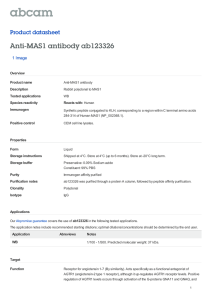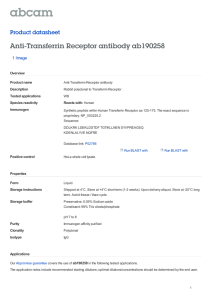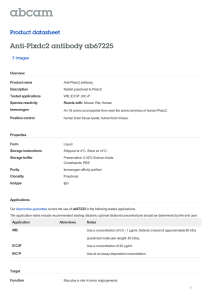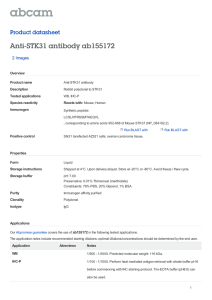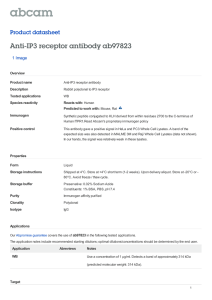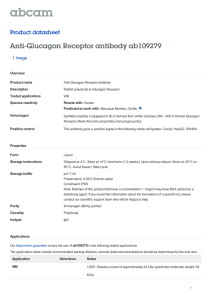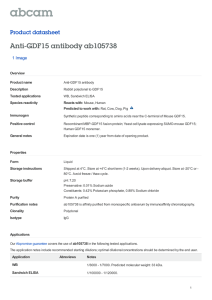Anti-beta 1 Adrenergic Receptor antibody ab3442 Product datasheet 3 Abreviews 3 Images
advertisement
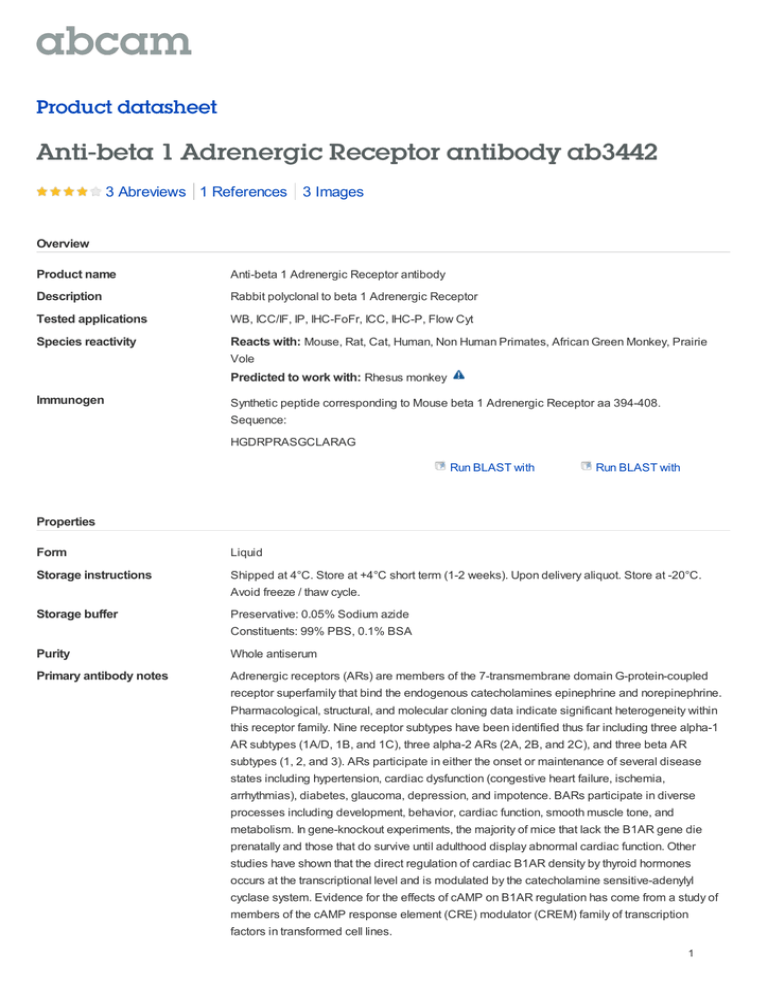
Product datasheet Anti-beta 1 Adrenergic Receptor antibody ab3442 3 Abreviews 1 References 3 Images Overview Product name Anti-beta 1 Adrenergic Receptor antibody Description Rabbit polyclonal to beta 1 Adrenergic Receptor Tested applications WB, ICC/IF, IP, IHC-FoFr, ICC, IHC-P, Flow Cyt Species reactivity Reacts with: Mouse, Rat, Cat, Human, Non Human Primates, African Green Monkey, Prairie Vole Predicted to work with: Rhesus monkey Immunogen Synthetic peptide corresponding to Mouse beta 1 Adrenergic Receptor aa 394-408. Sequence: HGDRPRASGCLARAG Run BLAST with Run BLAST with Properties Form Liquid Storage instructions Shipped at 4°C. Store at +4°C short term (1-2 weeks). Upon delivery aliquot. Store at -20°C. Avoid freeze / thaw cycle. Storage buffer Preservative: 0.05% Sodium azide Constituents: 99% PBS, 0.1% BSA Purity Whole antiserum Primary antibody notes Adrenergic receptors (ARs) are members of the 7-transmembrane domain G-protein-coupled receptor superfamily that bind the endogenous catecholamines epinephrine and norepinephrine. Pharmacological, structural, and molecular cloning data indicate significant heterogeneity within this receptor family. Nine receptor subtypes have been identified thus far including three alpha-1 AR subtypes (1A/D, 1B, and 1C), three alpha-2 ARs (2A, 2B, and 2C), and three beta AR subtypes (1, 2, and 3). ARs participate in either the onset or maintenance of several disease states including hypertension, cardiac dysfunction (congestive heart failure, ischemia, arrhythmias), diabetes, glaucoma, depression, and impotence. BARs participate in diverse processes including development, behavior, cardiac function, smooth muscle tone, and metabolism. In gene-knockout experiments, the majority of mice that lack the B1AR gene die prenatally and those that do survive until adulthood display abnormal cardiac function. Other studies have shown that the direct regulation of cardiac B1AR density by thyroid hormones occurs at the transcriptional level and is modulated by the catecholamine sensitive-adenylyl cyclase system. Evidence for the effects of cAMP on B1AR regulation has come from a study of members of the cAMP response element (CRE) modulator (CREM) family of transcription factors in transformed cell lines. 1 Clonality Polyclonal Isotype IgG Applications Our Abpromise guarantee covers the use of ab3442 in the following tested applications. The application notes include recommended starting dilutions; optimal dilutions/concentrations should be determined by the end user. Application Abreviews WB Notes 1/1000. Detects a band of approximately 50.5 kDa (predicted molecular weight: 50 kDa). ICC/IF 1/100. Immunofluorescence staining of B1AR in mouse kidney distal tubule yields a pattern consistent with plasma membrane staining. IP Use at an assay dependent concentration. IHC-FoFr Use at an assay dependent concentration. ICC 1/5000. IHC-P 1/200. Flow Cyt Use at an assay dependent concentration. ab171870 - Rabbit polyclonal IgG, is suitable for use as an isotype control with this antibody. Target Function Beta-adrenergic receptors mediate the catecholamine-induced activation of adenylate cyclase through the action of G proteins. This receptor binds epinephrine and norepinephrine with approximately equal affinity. Sequence similarities Belongs to the G-protein coupled receptor 1 family. Adrenergic receptor subfamily. ADRB1 subsubfamily. Domain The PDZ domain-binding motif mediates competitive interactions with GOPC, MAGI3 and DLG4 and plays a role in subcellular location of the receptor. Post-translational modifications Homologous desensitization of the receptor is mediated by its phosphorylation by betaadrenergic receptor kinase. Cellular localization Cell membrane. Localized at the plasma membrane. Found in the Golgi upon GOPC overexpression. Anti-beta 1 Adrenergic Receptor antibody images 2 All lanes : Anti-beta 1 Adrenergic Receptor antibody (ab3442) at 1/1000 dilution Lane 1 : As above Lane 2 : As above Lane 3 : As above Lane 4 : As above Western blot - Anti-beta 1 Adrenergic Receptor Lane 5 : As above antibody (ab3442) Lane 6 : As above Lane 7 : As above Lane 8 : As above Lane 9 : As above Lane 10 : As above Lane 11 : As above Lane 12 : As above Lysates/proteins at 25 µg per lane. Secondary HRP-conjugated Goat anti-Rabbit at 1/20000 dilution Predicted band size : 50 kDa Observed band size : 50 kDa Additional bands at : 30 kDa. We are unsure as to the identity of these extra bands.Western blot analysis of ADR-Beta-1 was performed by loading 25ug of various whole cell lysates onto a 4-20% Tris-HCl polyacrylamide gel. Proteins were transferred to a PVDF membrane and blocked with 5% Milk/TBST for at least 1 hour. Membranes were probed with ab3442 at a dilution of 1/1000 overnight at 4°C on a rocking platform. Membranes were washed in TBS0.1%Tween 20 and probed with a goat antirabbit-HRP secondary antibody at a dilution of 1/20,000 for at least one hour. Membranes were washed and chemiluminescent detection performed. 3 ab3442 at 1/100 dilution staining beta 1 Adrenergic Receptor in untreated HeLa cells by Immunocytochemistry/ Immunofluorescence. Formalin fixed cells Immunocytochemistry/ Immunofluorescence Anti-beta 1 Adrenergic Receptor antibody (ab3442) were permeabilized with 0.1% Triton X-100 in TBS for 15 minutes at room temperature. Cells were then blocked with 5% normal goat serum for 15 minutes at room temperature. Cells were probed with a rabbit polyclonal antibody recognizing ADR-Beta-1, at a dilution of 1/100 for at least 1 hour at room temperature. Cells were washed with PBS and incubated with DyLight 488-conjugated goat-anti-rabbit secondary antibody at a dilution of 1/400 for 30 minutes at room temperature. Nuclei were stained with Hoechst 33342 dye. ab3442 staining the beta 1 Adrenergic Receptor in mouse bone marrow cells by Flow Cytometry. Cells were fixed with paraformaldehyde and permeabilized with 0.5% BSA in 2mM EDTA/PBS. The sample was incubated with the primary antibody Flow Cytometry - Anti-beta 1 Adrenergic Receptor (1/100) for 20 minutes at 4°C. An Alexa antibody (ab3442) This image is courtesy of an anonymous Abreview Fluor® 488-conjugated goat anti-rabbit IgG polyclonal (1/1000) was used as the secondary antibody. Gating Strategy: Blood cells. Please note: All products are "FOR RESEARCH USE ONLY AND ARE NOT INTENDED FOR DIAGNOSTIC OR THERAPEUTIC USE" Our Abpromise to you: Quality guaranteed and expert technical support Replacement or refund for products not performing as stated on the datasheet Valid for 12 months from date of delivery Response to your inquiry within 24 hours We provide support in Chinese, English, French, German, Japanese and Spanish Extensive multi-media technical resources to help you We investigate all quality concerns to ensure our products perform to the highest standards If the product does not perform as described on this datasheet, we will offer a refund or replacement. For full details of the Abpromise, please visit http://www.abcam.com/abpromise or contact our technical team. Terms and conditions Guarantee only valid for products bought direct from Abcam or one of our authorized distributors 4 5
